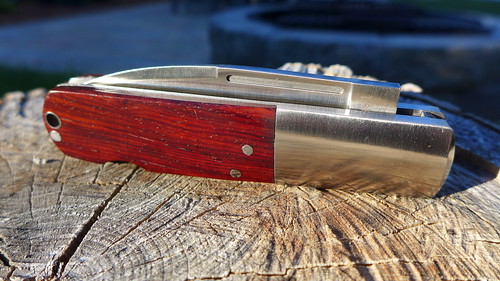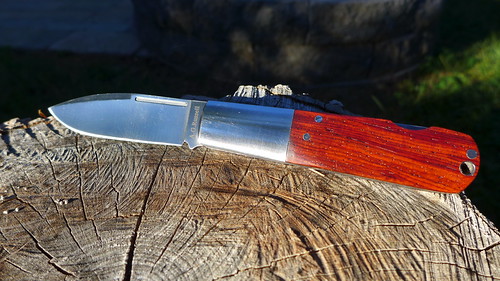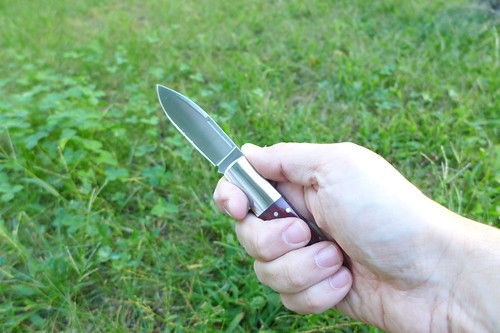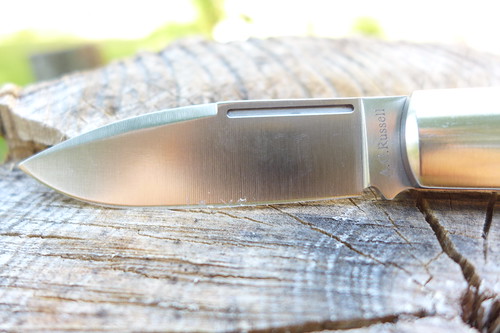AG Russell Medium Barlow Review
Hiding things in plain sight is always wonderful design trick and here, in the AG Russell Medium Barlow, you have a traditional knife that is actually a modern one hand opening blade (for that reason, I am using the modern knife scale; I also haven't figured out how to score traditional knives yet...). It looks like your grandpa's knife but performs like the very best under $50 cutlery made today. It is elegant, yet plenty tough. It is small enough to drop in the pocket without a problem, but big enough to handle almost every task I could throw at it. The history of the Barlow is fascinating. The idea that this most traditional of patterns has been revamped with steel made from China and modern touches that make it exceed the original vision of the blade is a testament to the genius that is AG Russell. AG proves, yet again, that greatness and creativity aren't limited by age (in fact, Time Magazine did an excellent piece on the notion that age actually enhances creativity because of the way the brain adapts to the aging process). This is the 21st Century Barlow, an eminently pocketable blade that is probably the first knife pattern designed specifically for EDC (the pattern is at least 200 years old).
Here is the product page. There are three models, the yellow delrin handled version that costs $35, the black Rucarta handle that costs $40, and the cocobolo handled version that costs $45. There are also large and small versions of the Russell Barlow. There are no review or video reviews, though there is a good thread about them over on Blade Forums, found here.
Here is my video overview of the knife:
Here is my review sample, which I purchased with my own money:
Twitter Review Summary: A unique blend of traditional and modern knife design in a classy, well-made and affordable package.
Design: 2
The extra long bolster that is typical of the Barlow style is set off here by a strikingly colored slab of cocobolo, mine being a bit more purple than the typical cut of that species (which is usually a powerful black and tan color). The design has been around for so long because it is so damn good--the shape is pleasing to the hand and the look is sweet to the eye. The knife feels solid without being chubby, and the tear drop shape nestles into the meat of your palm quite nicely. This is a knife that looks very, very good and handles equally well.
AG Russell's touch is two fold. First he drops a lock back, of the tail lock variety, on this blade, which is not that big of a departure from the normal Barlow set up. Then he adds a very deep french cut. It, of course, facilitates two hand opening, but it also allows very easy one hand opening. It is such a brilliant touch--it makes the knife look like an old timey blade, but it really works as a one hand opener. EXCELLENT.
Here is the knife next to the MBI HF-R Ti:
The knife's size is excellent. The blade is a very good 2 7/8 inches in a 3 1/2 handle. Of course, because this is an AG Russell knife, he pays attention to those details, cramming a lot of blade into the handle for a great blade:handle of .82, tying the ratio super champ, the Al Mar Ultralight Hawk. The blade:weight is no where near as good, but it is still respectable at .99.
Fit and Finish: 2
When people think of overseas made knives, there are Swiss blades from Klotzli, which have a reputation similar to that of Swiss watches. There are German knives that people appreciate and Italian made knives that people are starting to really like. Spyderco fans rejoice when Taichung Taiwan makes a blade, but thus far China has not received any love.
The Barlow is proof that our old, simple "Where is this made?" line of inquiry is no longer helpful. This is an expertly finished Chinese made knife. The bolster gleams, the grind is clean, the cocobolo is nicely finished (it looks positively mesmerizing in the late day sun in the photo above). The pins are amazingly flush. They are smooth to the touch, an impressive feat, as finger tips can feel things down to 1/1000th of an inch. The walk and talk is not a great as it would be on a non-locking slip joint folder, but that is because the pivot is smoothed out and the spring isn't as tight to allow for one hand opening. This is a very well-made knife. For $40 there is nothing to complain about. For $100 there is probably still nothing to complain about. Whatever AG did, others should take note--this is what you should expect from your Chinese OEMs.
Grip: 2
I became aware of gear in a serious way through YouTube and that means that part of what I think of when I think of grip is jimping, but Anso has shown me a way out of the jimping maze. A good well designed EDC knife doesn't need jimping. The tasks don't demand it and a curve here or a cut there can do everything you need it to grip-wise. The Barlow's grip secret is seen here:
The tear drop rear of the knife is perfect for nestling into your palm, sitting just below the muscle that controls your thumb. Without a sharp or point edge, you get a lot of back up from the shape of your hand, especially in piercing cuts where grip is more important. In slicing and roll cuts the nice rounded bolster helps out as well. When a knife pattern is this old, you have to figure that it stuck around for a reason. The nice grip is one reason why the Barlow is still around.
Carry: 2
The knife's size and curvy tail end make for an excellent pocket companion, even without a clip. The whole package is small enough to fit into your coin pocket (geez, I always want to write "coin slot" but that is something totally different). The only ding I have against the knife comes in the form of the very exposed and pointy rear tang. Its a minor ding, its not as sharp as it is on other knives, and the pattern requires it to be exposed, but still. Very good, definitely above average, but not perfect.
Steel: 1
Okay, I am going to admit it--I was wrong about 8Cr13MoV. Properly done, it is a very passable steel, certainly average. I know because I broke the edge on this knife down in one day. I got the blade on a Friday and the next day, a Saturday, I absolutely massacred the edge, cutting down boxes, doing food prep, and starting a fire. I did this purpose as I wanted to get an idea of exactly what the 8Cr steel can do. After the extensive use, I was able to sharpen it and bring the edge completely back, maybe a little better than factory (it came especially sharp). Aaron always says that really sharpening a steel gives you a feel for its performance and I agree. This is a steel that can do quite a bit of cutting very well. Why did I miss it before? Almost all of the 8Cr I used was disguised. It was disguised by a bead blast finish.
If you look back at all of the blades I have reviewed with 8Cr it had a bead blast finish or a bead blast with a coating. Bead blast is known to open up the pores of steel to make them more receptive to rust and discoloration and my use with knives like the OD-2 and the Injection shows this is the case. But what I was confusing was the properties of 8Cr13MoV with the properties of a bead blasted 8Cr13MoV. The knife world has known for a long time that mirror polishing improves corrosion resistance making even high carbon steels behave more like stainless steels. The same is true for bead blasted 8Cr13MoV. When done right, like here, it is actually quite good. The edge retention is lacking, but instead of being poor at both edge retention and corrosion resistance, it now seems to be just poor at edge retention.
In reality I struggle to find the difference between a good rendition of 8Cr13MoV and AUS-8, other than the country of origin. Breaking the edge down completely, and I mean completely, this thing was dull, and bringing it back has proven that 8Cr13MoV is not the garbage that many, including myself, had thought.
Blade Shape: 2
Russell calls this a Zulu Spear blade shape, but whatever its name, the reality is this a very useful profile. The swedge cuts weight but still leaves enough steel behind the tip. The drop point is nice and non-threatening. The ricasso allows for the edge to be sharpened all the way to the end of the blade.
Again, I am struck by how successful and useful simple blade shapes are.
Grind: 2
The Barlow's grind shows that the Chinese can make a knife and they understand in a fundamental way what makes it work. Here the grind is a hollow grind, thankfully it looks like the FFG trend is coming to its end, and the cutting bevel is very clean and even. The Barlow's grind blows away other Chinese 8Cr knives, most especially the Spyderco Tenacious. There was no end to the messiness there, but here you get a clean, crisp cutting edge and after all, isn't that the point.
Deployment Method: 2
Surprise! This is a one hand opening knife. Of all the clever things about the Barlow design, this is the cleverest. I had no idea this was even possible until I watched the AG Russell video. I thought, at first, that the present was a finger yoga master (or a finger yoga yogi to be correct and precise). But as it turns out that little French cut is plenty grippy to snag the pad of your thumb and help you pop this knife open. The notion that this LOOKS like a traditional knife but works like a modern one is so appealing in an EDC blade. Nothing is more people friendly then a blade that looks like something their grandpa used, but to have that look in a knife that works like a Spyderco is just awesome. I'd give this a 3 if I could without breaking the scale.
Retention Method: 0
No clip, no bail, just a lanyard hole. I hate lanyards. If the knife was bigger this would be an issue, as it is, I am not bent out of shape about it.
Lock: 2
The lockback is a vastly underrated lock. It is stable, low maintenance, and very sturdy. Here the tail lock like placement of the release lever helps accentuate the traditional pattern and the lock itself induces very little blade play. I genuinely like feel of its crisp disengagement. A very good lock for the money.
Overall Score: 17 out of 20
Few knives on the market make as interesting a choice for an EDC blade as Russell's Medium Barlow. It has a fascinating history (article forthcoming on this topic, I feel down a rabbit hole here), an elegant appearance, very good performance, and as people friendly look as possible. Plus it opens with one hand. The AG Russell Medium Barlow is proof positive that the Good Ole Boy from Arkansas is still at the top of his game--satisfying olde timey knife fans and pleasing those of us of a more modern bent all at the same time. For $40 you'd be hard pressed to find something that performs better, looks nicer, or is as unique. When was the last time you saw this knife on a pocket dump site or a YouTube video? That's my point. If you haven't tried a Russell blade, you'll be pleasantly surprised. I have a feeling that in 50 years people will be scoffing at how good a deal these knives are and a few will show up on the Antique's Roadshow 2063 where a person with a tiny wooden pointer will show the camera (a 3D holo-camera) all of the finer points and then stun the crowd at home by telling them that AG Russell knives sold for only $40 at the time.
Here is the product page. There are three models, the yellow delrin handled version that costs $35, the black Rucarta handle that costs $40, and the cocobolo handled version that costs $45. There are also large and small versions of the Russell Barlow. There are no review or video reviews, though there is a good thread about them over on Blade Forums, found here.
Here is my video overview of the knife:
Here is my review sample, which I purchased with my own money:
Twitter Review Summary: A unique blend of traditional and modern knife design in a classy, well-made and affordable package.
Design: 2
The extra long bolster that is typical of the Barlow style is set off here by a strikingly colored slab of cocobolo, mine being a bit more purple than the typical cut of that species (which is usually a powerful black and tan color). The design has been around for so long because it is so damn good--the shape is pleasing to the hand and the look is sweet to the eye. The knife feels solid without being chubby, and the tear drop shape nestles into the meat of your palm quite nicely. This is a knife that looks very, very good and handles equally well.
AG Russell's touch is two fold. First he drops a lock back, of the tail lock variety, on this blade, which is not that big of a departure from the normal Barlow set up. Then he adds a very deep french cut. It, of course, facilitates two hand opening, but it also allows very easy one hand opening. It is such a brilliant touch--it makes the knife look like an old timey blade, but it really works as a one hand opener. EXCELLENT.
Here is the knife next to the MBI HF-R Ti:
The knife's size is excellent. The blade is a very good 2 7/8 inches in a 3 1/2 handle. Of course, because this is an AG Russell knife, he pays attention to those details, cramming a lot of blade into the handle for a great blade:handle of .82, tying the ratio super champ, the Al Mar Ultralight Hawk. The blade:weight is no where near as good, but it is still respectable at .99.
Fit and Finish: 2
When people think of overseas made knives, there are Swiss blades from Klotzli, which have a reputation similar to that of Swiss watches. There are German knives that people appreciate and Italian made knives that people are starting to really like. Spyderco fans rejoice when Taichung Taiwan makes a blade, but thus far China has not received any love.
The Barlow is proof that our old, simple "Where is this made?" line of inquiry is no longer helpful. This is an expertly finished Chinese made knife. The bolster gleams, the grind is clean, the cocobolo is nicely finished (it looks positively mesmerizing in the late day sun in the photo above). The pins are amazingly flush. They are smooth to the touch, an impressive feat, as finger tips can feel things down to 1/1000th of an inch. The walk and talk is not a great as it would be on a non-locking slip joint folder, but that is because the pivot is smoothed out and the spring isn't as tight to allow for one hand opening. This is a very well-made knife. For $40 there is nothing to complain about. For $100 there is probably still nothing to complain about. Whatever AG did, others should take note--this is what you should expect from your Chinese OEMs.
Grip: 2
I became aware of gear in a serious way through YouTube and that means that part of what I think of when I think of grip is jimping, but Anso has shown me a way out of the jimping maze. A good well designed EDC knife doesn't need jimping. The tasks don't demand it and a curve here or a cut there can do everything you need it to grip-wise. The Barlow's grip secret is seen here:
The tear drop rear of the knife is perfect for nestling into your palm, sitting just below the muscle that controls your thumb. Without a sharp or point edge, you get a lot of back up from the shape of your hand, especially in piercing cuts where grip is more important. In slicing and roll cuts the nice rounded bolster helps out as well. When a knife pattern is this old, you have to figure that it stuck around for a reason. The nice grip is one reason why the Barlow is still around.
Carry: 2
The knife's size and curvy tail end make for an excellent pocket companion, even without a clip. The whole package is small enough to fit into your coin pocket (geez, I always want to write "coin slot" but that is something totally different). The only ding I have against the knife comes in the form of the very exposed and pointy rear tang. Its a minor ding, its not as sharp as it is on other knives, and the pattern requires it to be exposed, but still. Very good, definitely above average, but not perfect.
Steel: 1
Okay, I am going to admit it--I was wrong about 8Cr13MoV. Properly done, it is a very passable steel, certainly average. I know because I broke the edge on this knife down in one day. I got the blade on a Friday and the next day, a Saturday, I absolutely massacred the edge, cutting down boxes, doing food prep, and starting a fire. I did this purpose as I wanted to get an idea of exactly what the 8Cr steel can do. After the extensive use, I was able to sharpen it and bring the edge completely back, maybe a little better than factory (it came especially sharp). Aaron always says that really sharpening a steel gives you a feel for its performance and I agree. This is a steel that can do quite a bit of cutting very well. Why did I miss it before? Almost all of the 8Cr I used was disguised. It was disguised by a bead blast finish.
If you look back at all of the blades I have reviewed with 8Cr it had a bead blast finish or a bead blast with a coating. Bead blast is known to open up the pores of steel to make them more receptive to rust and discoloration and my use with knives like the OD-2 and the Injection shows this is the case. But what I was confusing was the properties of 8Cr13MoV with the properties of a bead blasted 8Cr13MoV. The knife world has known for a long time that mirror polishing improves corrosion resistance making even high carbon steels behave more like stainless steels. The same is true for bead blasted 8Cr13MoV. When done right, like here, it is actually quite good. The edge retention is lacking, but instead of being poor at both edge retention and corrosion resistance, it now seems to be just poor at edge retention.
In reality I struggle to find the difference between a good rendition of 8Cr13MoV and AUS-8, other than the country of origin. Breaking the edge down completely, and I mean completely, this thing was dull, and bringing it back has proven that 8Cr13MoV is not the garbage that many, including myself, had thought.
Blade Shape: 2
Russell calls this a Zulu Spear blade shape, but whatever its name, the reality is this a very useful profile. The swedge cuts weight but still leaves enough steel behind the tip. The drop point is nice and non-threatening. The ricasso allows for the edge to be sharpened all the way to the end of the blade.
Again, I am struck by how successful and useful simple blade shapes are.
Grind: 2
The Barlow's grind shows that the Chinese can make a knife and they understand in a fundamental way what makes it work. Here the grind is a hollow grind, thankfully it looks like the FFG trend is coming to its end, and the cutting bevel is very clean and even. The Barlow's grind blows away other Chinese 8Cr knives, most especially the Spyderco Tenacious. There was no end to the messiness there, but here you get a clean, crisp cutting edge and after all, isn't that the point.
Deployment Method: 2
Surprise! This is a one hand opening knife. Of all the clever things about the Barlow design, this is the cleverest. I had no idea this was even possible until I watched the AG Russell video. I thought, at first, that the present was a finger yoga master (or a finger yoga yogi to be correct and precise). But as it turns out that little French cut is plenty grippy to snag the pad of your thumb and help you pop this knife open. The notion that this LOOKS like a traditional knife but works like a modern one is so appealing in an EDC blade. Nothing is more people friendly then a blade that looks like something their grandpa used, but to have that look in a knife that works like a Spyderco is just awesome. I'd give this a 3 if I could without breaking the scale.
Retention Method: 0
No clip, no bail, just a lanyard hole. I hate lanyards. If the knife was bigger this would be an issue, as it is, I am not bent out of shape about it.
Lock: 2
The lockback is a vastly underrated lock. It is stable, low maintenance, and very sturdy. Here the tail lock like placement of the release lever helps accentuate the traditional pattern and the lock itself induces very little blade play. I genuinely like feel of its crisp disengagement. A very good lock for the money.
Overall Score: 17 out of 20
Few knives on the market make as interesting a choice for an EDC blade as Russell's Medium Barlow. It has a fascinating history (article forthcoming on this topic, I feel down a rabbit hole here), an elegant appearance, very good performance, and as people friendly look as possible. Plus it opens with one hand. The AG Russell Medium Barlow is proof positive that the Good Ole Boy from Arkansas is still at the top of his game--satisfying olde timey knife fans and pleasing those of us of a more modern bent all at the same time. For $40 you'd be hard pressed to find something that performs better, looks nicer, or is as unique. When was the last time you saw this knife on a pocket dump site or a YouTube video? That's my point. If you haven't tried a Russell blade, you'll be pleasantly surprised. I have a feeling that in 50 years people will be scoffing at how good a deal these knives are and a few will show up on the Antique's Roadshow 2063 where a person with a tiny wooden pointer will show the camera (a 3D holo-camera) all of the finer points and then stun the crowd at home by telling them that AG Russell knives sold for only $40 at the time.





